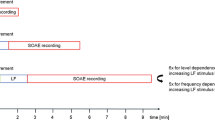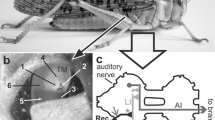Abstract
Some hearing organs demonstrate frequency tuning that is strongly temperature-dependent whereas others do not. Previous experiments in mammals have shown little, if any, temperature-dependence. Spontaneous otoacoustic emissions (SOAEs) are very stable in some subjects and offer a sensitive indicator for temperature effects. SOAE frequency changes were investigated over the menstrual cycle, the diurnal cycle, and after irrigation of the ear canal. A consistent apparent negative correlation with temperature was found over the menstrual cycle. Over the diurnal cycle, however, different frequency components behaved differently with a negligible net temperature-dependence. Irrigation of the ear canal at 30°C indicated a slight negative temperature dependence, but further experiments on another subject gave opposite changes for 30°C but no change for 44°C. These latter effects may have been due to changes of middle-ear pressure, whereas the effects over the menstrual cycle may be due to changes of hormone level. The temperature dependence of human frequency tuning would appear to be less than 0.1%/°C, indicating a stiffness change of less than 0.2%/°C.
Access this chapter
Tax calculation will be finalised at checkout
Purchases are for personal use only
Preview
Unable to display preview. Download preview PDF.
Similar content being viewed by others
References
Bass, A.H., and Hopkins, C.D. (1984): Shifts in frequency tuning of electroreceptors in androgen-treated mormyrid fish. J. Comp. Physiol. A. 155, 713–724.
Eatock, R.A., and Manley, G.A. (1981): Auditory nerve fibre activity in the Tokay gecko: II. Temperature effect on tuning. J. Comp. Physiol. 142, 219–226.
Emde, C. and Klinke, R. (1977): Does absolute pitch depend on an internal clock? In: Inner Ear Biology. Eds: M. Portmann and J.M. Aran, INSERM, Paris, 68, 145–146.
Gibbs, E.R. (1984): Hormonal factors in hearing. B. Med. Sc. project report, University of Nottingham.
Gummer, A.W. and Klinke, R. (1983): Influence of temperature on tuning of primary-like units in the guinea pig cochlear nucleus. Hearing Res. 12, 367–380.
Kemp, D.T. (1979): The evoked cochlear mechanical response and the auditory microstructure — evidence for a new element in cochlear mechanics. Scand. Audiol. Suppl. 9, 35–47.
Khanna, S.M. and Leonard, D.G.B. (1982): Basilar membrane tuning in the cat cochlea. Science 215, 305–306.
Klinke, R. and Smolders, J. (1977): Effect of temperature shift on tuning properties. In: Psychophysics and Physiology of Hearing. Eds. E.F. Evans & J.P. Wilson. Academic Press, Lond. pp. 109–112.
Moffat, A.J.M. and Capranica, R.R. (1976): Effects of temperature on the response properties of auditory nerve fibers in the American toad (Bufo americanus). J. Acoust. Soc. Am. 60, S80.
Mountain, D.C. (1980): Changes in endolymphatic potential and crossed olivocochlear bundle stimulation alter cochlear mechanics. Science 210, 71–71.
Palmer, A.R. and Wilson, J.P. (1982): Spontaneous and evoked acoustic emissions in the frog Rana esculenta.J. Physiol. 324, 66P.
Schermuly, L. and Klinke, R. (1982): Tuning properties of pigeon primary auditory afferents depend on temperature. Pflüg. Arch. Suppl. 394, R63.
Sellick, P.M., Patuzzi, R. and Johnstone, B.M. (1982): Measurement of basilar membrane motion in guinea pig using the Mössbauer technique. J. Acoust. Soc. Am. 72, 131–141.
Smolders, J. and Klinke, R. (1984): Effects of temperature on the properties of primary auditory fibres of the spectacled caiman, Caiman crocodilus (L.). J. Comp. Physiol. 155, 19–30.
Strack, G., Klinke, R. and Wilson, J.P. (1981): Evoked cochlear responses in Caiman crocodilus.Pflügers Arch. Suppl. 391, R43.
Wilson, J.P. (1980): Evidence for a cochlear origin for acoustic re-emissions, threshold fine-structure and tonal tinnitus. Hear. Res. 2, 233–252.
Wilson, J.P., Smolders, J.W.T., and Klinke, R. (1985): Mechanics of the basilar membrane in Caiman crocodilus.Hear. Res. 18, 1–14.
Wilson, J.P., and Sutton, G.J. (1981): Acoustic correlates of tonal tinnitus. In: Tinnitus, Eds. D. Evered and G. Lawrenson, Pitman Medical, Lond., 82–107.
Wynn, V.T. (1973): Absolute pitch in humans, its variation and possible connection with other known rhythmic phenomena. Prog. in Neurobiol. 1, 113–143.
Zurek, P.M. (1981): Spontaneous narrowband acoustic signals emitted by human ears. J. Acoust. Soc. Am. 69, 514–523.
Author information
Authors and Affiliations
Editor information
Editors and Affiliations
Rights and permissions
Copyright information
© 1986 Springer-Verlag Berlin Heidelberg
About this paper
Cite this paper
Wilson, J.P. (1986). The Influence of Temperature on Frequency-Tuning Mechanisms. In: Allen, J.B., Hall, J.L., Hubbard, A.E., Neely, S.T., Tubis, A. (eds) Peripheral Auditory Mechanisms. Lecture Notes in Biomathematics, vol 64. Springer, Berlin, Heidelberg. https://doi.org/10.1007/978-3-642-50038-1_29
Download citation
DOI: https://doi.org/10.1007/978-3-642-50038-1_29
Publisher Name: Springer, Berlin, Heidelberg
Print ISBN: 978-3-540-16095-3
Online ISBN: 978-3-642-50038-1
eBook Packages: Springer Book Archive




